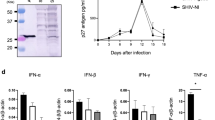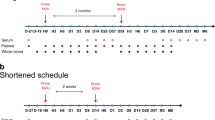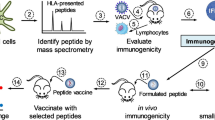Abstract
Infection by live attenuated retroviruses provides excellent protection from challenge with pathogenic viruses in several animal models, but little is known about which immune effectors are necessary for protection. We examined this using adoptive transfer experiments in the Friend virus mouse model. Transfers of immune spleen cells into naive mice conferred complete protection, and transfers of purified lymphocyte subsets demonstrated that this effect required complex immune responses involving CD4+ and CD8+ T cells and also B cells. In addition, passive immunization experiments demonstrated that antibodies alone reduced virus loads but did not prevent infection. These findings may have implications for retroviral vaccine design in general.
This is a preview of subscription content, access via your institution
Access options
Subscribe to this journal
Receive 12 print issues and online access
$209.00 per year
only $17.42 per issue
Buy this article
- Purchase on Springer Link
- Instant access to full article PDF
Prices may be subject to local taxes which are calculated during checkout





Similar content being viewed by others
References
Earl, P.L. et al. T–lymphocyte priming and protection against Friend leukemia by vaccinia–retrovirus env gene recombinant. Science 234, 728–731 (1986).
Daniel, M.D., Kirchhoff, F., Czajak, S.C., Sehgal, P.K., Desrosiers, R.C. Protective effects of a live attenuated SIV with a deletion in the nef gene. Science 258, 1938–1941 (1992).
Almond, N. et al. Protection by attenuated simian immunodeficiency virus in macaques against challenge with virus–infected cells. Lancet 345, 1342–1344 (1995).
Stahl–Hennig, C. et al. Attenuated SIV imparts immunity to challenge with pathogenic spleen–derived SIV but cannot prevent repair of the nef deletion. Immunol. Lett. 51, 129–135 (1996).
Ruprecht, R.M. et al. Vaccination with a live retrovirus: the nature of the protective immune response. Proc. Natl. Acad. Sci. USA 87, 5558–5562 (1990).
Desrosiers, R.C. Prospects for live attenuated HIV. Nature Med. 4, 982 (1998).
Baba, T.W. et al. Pathogenicity of live, attenuated SIV after mucosal infection of neonatal macaques. Science 267, 1820– 1825 (1995).
Cohen, J. Weakened SIV vaccine still kills. Science 278, 24–25 (1997).
Dittmer, U. et al. Cellular immune response of rhesus monkeys infected with a partially attenuated nef deletion mutant of the simian immunodeficiency virus. Virology 212, 392–397 (1995).
Dittmer, U. et al. Specificity of helper T cells generated from macaques infected with attenuated Simian Immunodeficiency Virus. J. Gen. Virol. 79, 1801–1807 (1998).
Xu, X.N. et al. Evasion of cytotoxic T lymphocyte (CTL) responses by nef–dependent induction of Fas ligand (CD95L) expression on simian immunodeficiency virus–infected cells. J. Exp. Med. 186, 7– 16 (1997).
Johnson, R.P. et al. Induction of vigorous cytotoxic T–lymphocyte responses by live attenuated simian immunodeficiency virus. J. Virol. 71, 7711–7718 (1997).
Norley, S., Beer, B., Binninger–Schinzel, D., Cosma, C. & Kurth, R. Protection from pathogenic SIVmac challenge following short–term infection with a nef–deficient attenuated virus. Virology 219, 195– 205 (1996).
Cole, K.S. et al. Evolution of envelope–specific antibody responses in monkeys experimentally infected or immunized with simian immunodeficiency virus and its association with the development of protective immunity. J. Virol. 71, 5069–5079 (1997).
Johnson, R.P. & Desrosiers, R.C. Protective immunity induced by live attenuated simian immunodeficiency virus. Curr. Opin. Immunol. 10, 436–443 (1998).
Heilman, C.A. & Baltimore, D. HIV vaccines—where are we going? Nature Med. 4, 532– 534 (1998).
Burton, D.R. & Moore, J.P. Why do we not have an HIV vaccine and how can we make one? Nature Med. 4, 495–498 (1998).
Morrison, R.P., Nishio, J. & Chesebro, B. Influence of the murine MHC (H–2) on Friend leukemia virus–induced immunosuppression. J. Exp. Med. 163, 301–314 (1986).
Ceglowski, W.S. & Friedman, H. Immunosuppression by leukemia viruses. I. Effect of Friend disease virus on cellular and humoral hemolysin responses of mice to a primary immunization with sheep erythrocytes. J. Immunol. 101, 594–604 (1968).
Jones, S.M., Moors, M.A., Ryan, Q., Klyczek, K.K. & Blank, K.J. Altered Macrophage Antigen–Presenting Cell Function Following Friend Leukemia Virus Infection. Viral Immunol. 5, 201–211 (1992).
Kabat, D. Molecular biology of Friend viral erythroleukemia. Curr. Top. Microbiol. Immunol. 148, 1–42 (1989).
Hoatlin, M.E. & Kabat, D. Host–range control of a retroviral disease: Friend erythroleukemia. Trends Microbiol. 3, 51–57 (1995).
Li, J.–P., D'Andrea, A.D., Lodish, H.F. & Baltimore, D. Activation of cell growth by binding of Friend spleen focus–forming virus gp55 glycoprotein to the erythropoietin receptor. Nature 343, 762–764 (1990).
Hasenkrug, K.J., Brooks, D. M., Robertson, M. N., Srinivas, R.V. & & Chesebro, B. Immunoprotective determinants in Friend Murine Leukemia Virus envelope protein. Virology 248, 66–73 (1998).
Wendling, F. & Tambourin, P.E. Oncogenicity of Friend–virus–infected cells: determination of origin of spleen colonies by the H–2 antigens as genetic markers. Int. J. Cancer 22, 479–86 (1978).
Lilly, F. Susceptibility to two strains of Friend leukemia virus in mice. Science 155, 461–462 (1967).
Dittmer, U., Brooks, D.M. & Hasenkrug, K.J. Characterization of a live–attenuated retroviral vaccine demonstrates protection via immune mechanisms. J. Virol. 72, 6554–6558 (1998).
Pincus, T., Rowe, W.P. & Lilly, F. A major genetic locus affecting resistance to infection with murine leukemia viruses. II. Apparent identity to a major locus described for resistance to Friend murine leukemia virus. J. Exp. Med. 133, 1234–1241 (1971).
Jolicoeur, P. The Fv–1 gene of the mouse and its control of murine leukemia virus replication. Curr. Top. Microbiol. Immunol. 86, 67–122 (1979).
Britt, W.J. & Chesebro, B. Use of monoclonal anti–gp70 antibodies to mimic the effects of the Rfv–3 gene in mice with Friend virus–induced leukemia. J. Immunol. 130, 2363–2367 (1983).
Hasenkrug, K.J., Brooks, D.M. & Chesebro, B. Passive immunotherapy for retroviral disease: influence of major histocompatibility complex type and T–cell responsiveness. Proc. Natl. Acad. Sci. USA 92, 10492– 10495 (1995).
Hasenkrug, K.J., Brooks, D.M. & Dittmer, U. Critical role for CD4+ T cells in controlling retrovirus replication and spread in persistently infected mice. J. Virol. 72, 6559–6564 (1998).
Perry, L.L. & Lodmell, D.L. Role of CD4+ and CD8+ T cells in murine resistance to street rabies virus. J. Virol. 65, 3429–3434 (1991).
Lodmell, D.L. & Ewalt, L.C. Pathogenesis of street rabies virus infections in resistant and susceptible strains of mice. J. Virol. 55, 788–795 (1985).
Weidt, G., Deppert, W., Buchhop, S., Dralle, H. & Lehmann–Grube, F. Antiviral protective immunity induced by major histocompatibility complex class I molecule–restricted viral T–lymphocyte epitopes inserted in various positions in immunologically self and nonself proteins. J. Virol. 69, 2654– 2658 (1995).
Oldstone, M.B. et al. Vaccination to prevent persistent viral infection. J. Virol. 67, 4372–4378 (1993).
Hom, R.C., Finberg, R.W., Mullaney, S. & Ruprecht, R.M. Protective cellular retroviral immunity requires both CD4+ and CD8+ immune T cells. J. Virol. 65, 220– 224 (1991).
Walker, C.M. & Levy, J.A. A diffusable lymphokine produced by CD8+ T lymphocytes suppresses HIV replication. Immunology 66, 628–630 (1989).
Mackewicz, C. & Levy, J.A. CD8+ cell anti–HIV activity: Nonlytic suppression of virus replication. AIDS Res. Hum. Retroviruses 8, 1039–1050 (1992).
Furci, L. et al. Antigen–driven C–C chemokine–mediated HIV–1 suppression by CD4+ T cells from exposed uninfected individuals expressing the wild–type CCR–5 allele. J. Exp. Med. 186, 455–460 (1997).
Salk, J., Bretscher, P.A., Salk, P.L., Clerici, M. & Shearer, G.M. A strategy for prophylactic vaccination against HIV. Science 260, 1270– 1272 (1993).
Emini, E.A. et al. Prevention of HIV–1 infection in chimpanzees by gp120 V3 domain–specific monoclonal antibody. Nature 355, 728–730 (1992).
Gauduin, M.C. et al. Passive immunization with a human monoclonal antibody protects hu–PBL–SCID mice against challenge by primary isolates of HIV–1. Nature Med. 3, 1389–93 (1997).
Letvin, N.L. Progress in the development of an HIV–1 vaccine. Science 280, 1875–80 (1998).
Letvin, N.L. et al. Potent, protective anti–HIV immune responses generated by bimodal HIV envelope DNA plus protein vaccination. Proc. Natl. Acad. Sci. USA 94, 9378–9383 (1997).
Heeney, J.L. et al. β–chemokines and neutralizing antibody titers correlate with sterilizing immunity generated in HIV–1 vaccinated macaques. Proc. Natl. Acad. Sci. USA 95, 10803– 10808 (1998).
Chesebro, B. et al. Characterization of monoclonal antibodies reactive with murine leukemia viruses: use in analysis of strains of Friend MCF and Friend ecotropic murine leukemia virus. Virology 127, 134–148 (1983).
Sitbon, M., Nishio, J., Wehrly, K., Lodmell, D. & Chesebro, B. Use of a focal immunofluorescence assay on live cells for quantitation of retroviruses: distinction of host range classes in virus mixtures and biological cloning of dual–tropic murine leukemia viruses. Virology 141, 110–108 (1985).
Morrison, R.P. et al. Different H–2 subregions influence immunization against retrovirus and immunosuppression. Nature 329, 729–732 (1987).
Chesebro, B. et al. Characterization of mouse monoclonal antibodies specific for Friend murine leukemia virus–induced erythroleukemia cells: Friend–specific and FMR–specific antigens. Virology 112, 131–144 (1981).
Acknowledgements
U.D. is supported by a fellowship from the 'Deutsche Forschungsgemeinschaft'.
Author information
Authors and Affiliations
Rights and permissions
About this article
Cite this article
Dittmer, U., Brooks, D. & Hasenkrug, K. Requirement for multiple lymphocyte subsets in protection by a live attenuated vaccine against retroviral infection. Nat Med 5, 189–193 (1999). https://doi.org/10.1038/5550
Received:
Accepted:
Issue Date:
DOI: https://doi.org/10.1038/5550
This article is cited by
-
Depleting myeloid-biased haematopoietic stem cells rejuvenates aged immunity
Nature (2024)
-
Construction of a recombinant avipoxvirus expressing the env gene of Zika virus as a novel putative preventive vaccine
Virology Journal (2021)
-
Induction of complex immune responses and strong protection against retrovirus challenge by adenovirus-based immunization depends on the order of vaccine delivery
Retrovirology (2017)
-
Interference of retroviral envelope with vaccine-induced CD8+ T cell responses is relieved by co-administration of cytokine-encoding vectors
Retrovirology (2017)
-
Combination of nanoparticle-based therapeutic vaccination and transient ablation of regulatory T cells enhances anti-viral immunity during chronic retroviral infection
Retrovirology (2016)



